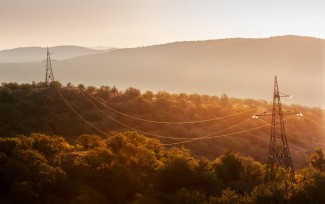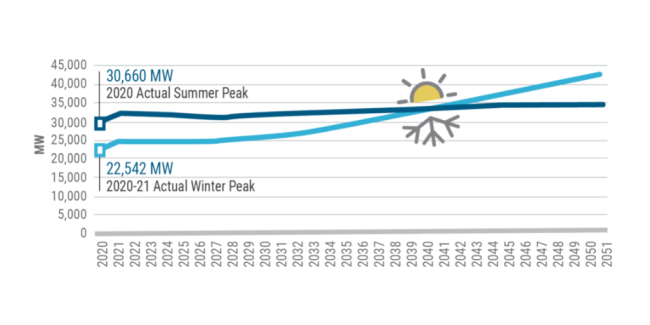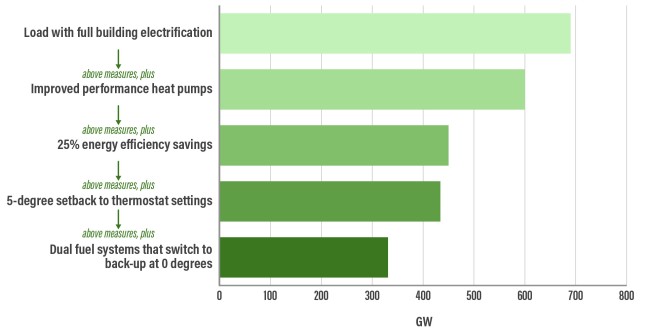Electrification of many buildings, vehicles, and factories—needed to address climate change—will increase electric demand in ways that require an evolution of the electric grid. About 20% of the emissions reductions in the International Energy Agency’s Net Zero scenario come from electrification. With more building heat coming from electricity instead of on-site fossil fuels, many regions will need to accommodate winter electricity demand that exceeds electricity consumption in the summer. Likewise, growing numbers of electric trucks and industrial heat pumps will mean the distribution grid in some locations will have to serve new multi-megawatt loads. Energy efficiency and demand response will become increasingly important to maintain grid reliability and to reduce the need for expensive new electricity generation and additional grid infrastructure.
Winter electric peaks will grow in much of the country
As electric heating loads grow, more regions will see electric loads peak in the winter. Most regions of the country now have their maximum loads (peak loads) on hot summer days, but some regions already have electric load peaks in the winter. For example, driven by electric heating loads and historically modest summer cooling loads, the Northwest is generally winter peaking. While summer cooling is growing in the region, so are installations of rooftop solar systems, which help reduce the demand on the grid on hot sunny days.
The Southeast also has a lot of electric heat, and as a result, some utilities peak in the summer, some in the winter, and some can peak in either season based on the weather. Texas is historically summer peaking, but the state has a lot of poorly insulated homes with inefficient electric resistance heat. As a result, the all-time peak would have been during 2020’s Winter Storm Uri, except that inadequate power supplies caused widespread blackouts.
Much of the rest of the United States has extensive cooling loads, with heating primarily served by natural gas and other fuels. As a result, electric utilities in these regions peak in the summer, but predicted growth in electric heat pumps replacing fossil fuel heating systems could result in winter peaking by the 2040s. California and Arizona, which are expected to continue being summer peaking, may be exceptions to this trend. The graph below shows the New York Independent System Operator’s forecast for winter load growth.
Source: New York Independent System Operator
Utilities need to plan for increased but uneven load growth
Growing use of electric passenger vehicles and residential heat pumps will necessitate moderate distribution upgrades. Extra capacity on many circuits, efforts to promote off-peak EV charging, and similarities between heat pumps and the central air conditioners they will frequently replace will often make this load growth manageable. For example, a detailed study on PG&E’s system found that to serve EV and residential heat pump loads, one to two upgrades to existing substations per year might be needed in the 2030s, increasing to three to five such upgrades per year in the 2040s across the service area where PG&E provides electricity to about 16 million people.
Very large new loads, such as for electrifying vehicle fleets and factories, will have even greater impacts on distribution systems. For example, a rough estimate of the power needed to serve a fleet of 200 delivery vans at an Amazon fulfillment center is about 4 megawatts. In Amsterdam, a 100-bus transit fleet is powered by slow and fast chargers that together have a peak load of 13 megawatts. Amsterdam is considering expanding the fleet to 250 buses. For electric 18-wheelers, chargers may need one to two megawatts of power each. National Grid, a utility serving parts of New York and Massachusetts, recently examined 71 highway sites in its territory for likely EV charging loads and concluded that about one-quarter of the sites will have loads of at least 5 megawatts by 2030 and that some high-demand charging sites could reach around 40 megawatts in peak charging capacity by 2045.
Likewise, large industrial heat pumps used to replace fossil fuel boilers in low- and medium-temperature industrial applications can also add substantial electric load. ACEEE analysis of about 30 industrial heat pump projects in Europe shows loads per heat pump ranging from about 25 kilowatts to about 1.25 megawatts. For comparison, a typical home central air conditioner might use 3.5 kilowatts, meaning that a 1.25-megawatt industrial heat pump is equivalent to about 350 such home systems (while the 13 megawatts for buses in Amsterdam is equivalent to about 3,700 such homes).
According to Black and Veatch, new loads of 5 megawatts typically require new circuits, new loads of 10 megawatts typically require new transformer banks, and new loads of 20 megawatts often require a new substation. These are all substantial investments. Typical utility costs can range from $150,000 to $6 million for primary distribution upgrades and $1 million to $9 million to upgrade an existing substation, according to the California Electric Transportation Coalition. New substations can cost significantly more. These types of investments are generally included in utility distribution investment plans, which are filed for regulatory approval every few years. To plan for these investments, utilities, site owners, and regulators need to work together to identify needed distribution improvements a few years in advance so that they can be included in these distribution investment plans.
Efficiency and load management can keep grid upgrades at affordable levels
Electrification can result in substantial load growth. According to the Brattle Group, “fully electrified heating and transportation (light- and heavy-duty vehicles, rail, etc.) could add up to 3,000 terawatts to U.S. electricity demand by 2050, nearly doubling 2015 electric load.” This is likely an extreme case since not everything will be electrified and because this estimate does not appear to include improvements in energy efficiency. In contrast, a 2017 ACEEE study on the Southeast included an aggressive scenario for energy efficiency, solar, and demand response that resulted in no growth in total electric loads through 2040 even with 34% of vehicles being EVs and 24% of fossil fuel-heated homes converted to heat pumps. The efficiency, solar, and demand response canceled out the load growth. With more aggressive EV and heat pump assumptions and with use of industrial heat pumps, there would be load growth.
The biggest U.S. grid challenges from the electrification of space heating are likely to be in the North, particularly with polar vortex weather events becoming more common. A 2020 paper I co-authored with Asa Hopkins and Kenji Takahashi of Synapse Energy Economics looks at what the electric loads would have been during January 2019 when a polar vortex swept across the Upper Midwest and Northeast. During this event, the peak power demand for this region was about 275 gigawatts (which is less than the 330-gigawatt 2018 summer peak in the region). If all residential and commercial buildings were fully electrified (cold-climate heat pumps with electric resistance backup), the load in the region would have been about 690 gigawatts, a 2.5-times increase. We found that various steps could reduce this load by more than half, to 331 gigawatts, as shown in the table below.
Note: Adding EV charging and industrial heat pumps would increase these figures.
More than doubling peak load would be expensive because much more generation would be needed as well as distribution and storage investments (the latter because the sun is low during early morning when winter load peaks). Severe cold snaps happen only every few years. It makes little sense to double the grid just to serve a very occasional load. These scenarios illustrate how energy efficiency, demand response, and fuel backups (which could be a decarbonized fuel) when temperatures get below zero can be combined to dramatically reduce added electric generation and grid upgrades.
Cooperative electric load planning will improve resilience while cutting costs and climate pollution
Electrification of buildings, vehicles, and industrial processes will have dramatic impacts on the electric grid. Without this electrification, the United States and the world will fall short of long-term climate targets, resulting in a warmer world and its catastrophic impacts.
Utilities, regulators, and property owners will need to work together to help plan the transition toward powering more and more of our economy with cleanly generated electricity. Vehicle fleet and factory owners need to tell utilities about their plans. Utilities need to incorporate these plans into their load and distribution forecasts and offer robust efficiency and demand response programs. Regulators need to encourage utilities to do this planning, and to promptly review plans that incorporate these new loads and programs.
If everyone works together, we will have a reliable grid and a cooler planet while minimizing costs. But if these steps do not happen, electric system reliability could be compromised, electrification efforts stymied, and power prices higher than they should be, all while exacerbating the impacts of climate change.





